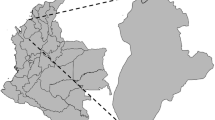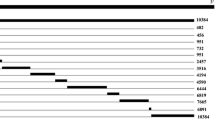Abstract
Venezuelan equine encephalitis virus (VEEV) is an important pathogen of medical and veterinary importance in the Americas. In this report, we present the complete genome sequences of five VEEV isolates obtained from pools of Culex (Melanoconion) gnomatos (4) or Culex (Melanoconion) pedroi (1) from Iquitos, Peru. Genetic and phylogenetic analyses showed that all five isolates grouped within the VEEV complex sister to VEEV IIIC and are members of subtype IIID. This is the first report of full-length genomic sequences of VEEV IIID.

Similar content being viewed by others
References
Griffin DE (2013) Alphaviruses. In: Fields BN, Knipe DM, Howley PM (eds) Fields virology, 6th edn. Wolters Kluwer Health/Lippincott Williams & Wilkins, Philadelphia, PA, pp 1023–1068
Nasar F, Palacios G, Gorchakov RV, Guzman H, Da Rosa AP, Savji N, Popov VL, Sherman MB, Lipkin WI, Tesh RB, Weaver SC (2012) Eilat virus, a unique alphavirus with host range restricted to insects by RNA replication. Proc Natl Acad Sci USA 109:14622–14627
Weaver SC, Ferro C, Barrera R, Boshell J, Navarro JC (2004) Venezuelan equine encephalitis. Annu Rev Entomol 49:141–174
Aguilar PV, Greene IP, Coffey LL, Medina G, Moncayo AC, Anishchenko M, Ludwig GV, Turell MJ, O’Guinn ML, Lee J, Tesh RB, Watts DM, Russell KL, Hice C, Yanoviak S, Morrison AC, Klein TA, Dohm DJ, Guzman H, Travassos da Rosa AP, Guevara C, Kochel T, Olson J, Cabezas C, Weaver SC (2004) Endemic Venezuelan equine encephalitis in northern Peru. Emerg Infect Dis 10:880–888
Turell MJ, O’Guinn ML, Jones JW, Sardelis MR, Dohm DJ, Watts DM, Fernandez R, Travassos da Rosa A, Guzman H, Tesh R, Rossi CA, Ludwig V, Mangiafico JA, Kondig J, Wasieloski LP Jr, Pecor J, Zyzak M, Schoeler G, Mores CN, Calampa C, Lee JS, Klein TA (2005) Isolation of viruses from mosquitoes (Diptera: Culicidae) collected in the Amazon Basin region of Peru. J Med Entomol 42:891–898
Djikeng A, Halpin R, Kuzmickas R, Depasse J, Feldblyum J, Sengamalay N, Afonso C, Zhang X, Anderson NG, Ghedin E, Spiro DJ (2008) Viral genome sequencing by random priming methods. BMC Genom 9:5
Leguia M, Loyola S, Rios J, Juarez D, Guevara C, Silva M, Prieto K, Wiley M, Kasper MR, Palacios G, Bausch DG (2015) Full genomic characterization of a saffold virus isolated in Peru. Pathogens 4:816–825
Altschul SF, Gish W, Miller W, Myers EW, Lipman DJ (1990) Basic local alignment search tool. J Mol Biol 215:403–410
Boisvert S, Raymond F, Godzaridis E, Laviolette F, Corbeil J (2012) Ray Meta: scalable de novo metagenome assembly and profiling. Genome Biol 13:R122
Schmieder R, Edwards R (2011) Quality control and preprocessing of metagenomic datasets. Bioinformatics 27:863–864
Edgar RC (2004) MUSCLE: multiple sequence alignment with high accuracy and high throughput. Nucleic Acids Res 32:1792–1797
Gouy M, Guindon S, Gascuel O (2010) SeaView version 4: a multiplatform graphical user interface for sequence alignment and phylogenetic tree building. Mol Biol Evol 27:221–224
Felsenstein J (1989) PHYLIP—phylogeny inference package (version 3.2). Cladistics 5:164–166
Acknowledgements
The authors would like to thank the many investigators who contributed to the epidemiological studies in Peru during the 1990s and early 2000s that led to the isolation of many arboviruses. Without their invaluable work, current and future experimental studies would not be possible.
Funding
This study was supported by a grant from the Military Infectious Diseases Research Program, ID# U0501-17-AF-CS-OC.
Author information
Authors and Affiliations
Corresponding author
Ethics declarations
Disclosure statement
The views expressed in this article are those of the authors and do not reflect the official policy or position of the U.S. Department of Defense, or the Department of the Army. I am a military service member /federal/contracted employee of the United States government. This work was prepared as part of my official duties. Title 17 U.S.C. 105 provides that ‘copyright protection under this title is not available for any work of the United States Government.’ Title 17 U.S.C. 101 defines U.S. Government work as work prepared by a military service member or employee of the U.S. Government as part of that person’s official duties.
Additional information
Handling Editor: Patricia Aguilar.
Publisher's Note
Springer Nature remains neutral with regard to jurisdictional claims in published maps and institutional affiliations.
Rights and permissions
About this article
Cite this article
Padilla, S.L., Prieto, K., Dohm, D.J. et al. Complete genomic sequences of Venezuelan equine encephalitis virus subtype IIID isolates from mosquitoes. Arch Virol 165, 1715–1717 (2020). https://doi.org/10.1007/s00705-020-04647-x
Received:
Accepted:
Published:
Issue Date:
DOI: https://doi.org/10.1007/s00705-020-04647-x




